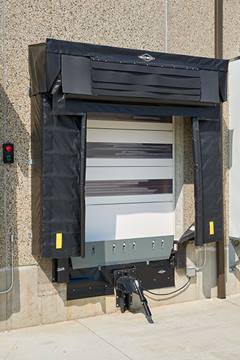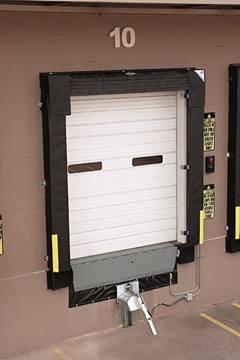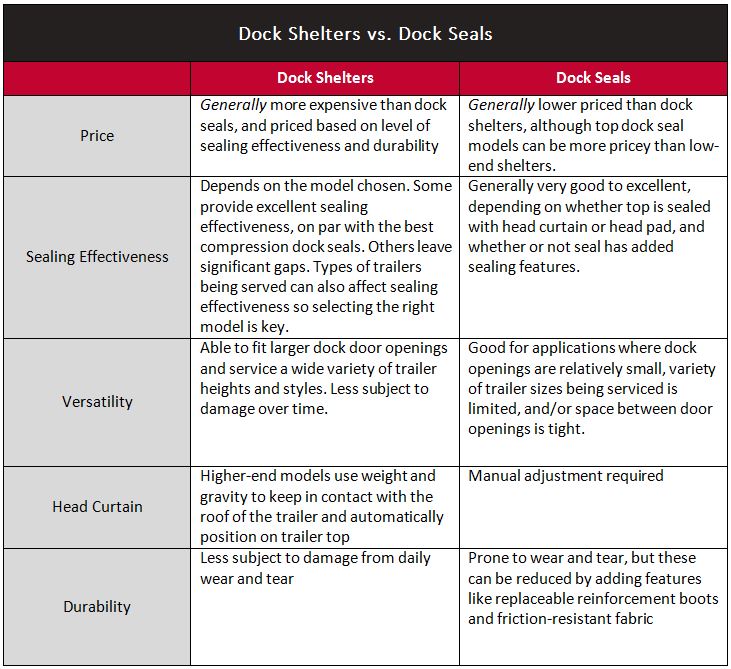Dock Seals vs Dock Shelters - The Differences and Benefits of Both
It may seem like a small issue, but each little gap you see around a parked trailer at the loading dock is costing you money each and every day.
The heating and air conditioning that escapes through these gaps can cost you hundreds of dollars per year, per dock position, and that’s just a start. Those gaps also allow unwanted outside elements like dust, wind, rain, bugs and rodents into your facility. This can easily contribute to product damage, cause issues with warehouse inspections and create an uncomfortable environment for your employees to work in.
To combat these areas, Rite-Hite provides a series of dock shelters and dock seals, to ensure that the only things going in and out of the loading dock door are things that should be. While dock shelters and seals have the same goal of environmental control, they are uniquely designed to serve different applications, so knowing the differences between the two will help you make the right choice for your needs.
Dock Shelters
Dock Shelters are enclosures that seal the perimeter of the trailer to form a seal. This is accomplished by applying pressure against the sides of the trailer with fabric curtains fitted with fiberglass stays. They fit larger dock door openings and service a wide variety of trailer heights and styles while being subjected to less damage from daily wear and tear since they aren’t designed to be compressed into by the trailer. They also allow for full, unobstructed access to loads on the trailer for maximum loading and unloading efficiency.

As a category, dock shelters historically could not provide as tight of a seal as foam dock seals, but newer models are equipped with features that allow them to match the sealing effectiveness of foam seals. For example, some older or less expensive dock shelters leave trailer door hinge gaps unsealed, amounting to about 2.5 sq ft of open space at every dock position through which energy flows out and contaminants flow in. Additionally, many shelters have less-than-ideal sealing at the tops of trailers, and most leave large corner gaps when the trailer is backed in. Newer models, like the Eclipse® shelter, however, include side curtains with a hook on the edge that wraps around the hinge gap on each side of the trailer, allowing for a complete seal. Plus trailer tops are more tightly sealed with weighted, gravity-based head curtains and corner gaps get plugged through engineered side curtain/head curtain functioning.
Dock Seals
Dock Seals are foam pads that the trailer compresses into when it backs in and comes to rest against the dock bumpers, forming a seal around three sides of the trailer. Generally, dock seals provide a tight seal for a relatively low price, but they can become worn easily at loading docks that receive heavy traffic. Dock seals are best used when there is a minor variation in the size and style of trailers being served.

Because of their design, foam compression dock seals can restrict forklift access to the trailer. This happens as foam and fabric from the dock seal side pads enter the trailer opening when they are compressed by the trailer. Dock seals, by design, however, typically take up less space on the outside of the dock, so if space is an issue then this may be the route that makes sense.
Like dock shelters, some dock seals perform better than others. Top-of-the-line dock seals are built with special features that protect against specific sources of damage, including trailer pressure and friction, burns from trailer marker lights, as well as head pad sag and pop-off.
Conclusion
To give you a clearer picture of how dock seals and shelters compare on a number of factors, see the chart that follows:

Ultimately, what’s important when choosing between a dock shelter or dock seal is determining the right solution that will help you to eliminate gaps at the dock in the most efficient way possible. Both options have their advantages and disadvantages.
We recommend talking with a trained professional to analyze your loading dock to give you the individual recommendation based on your specs, needs and restrictions. In the meantime, Rite-Hite has provided information on the different types of Dock Shelters and Dock Seals that we offer to give you an idea of what you should be looking for.